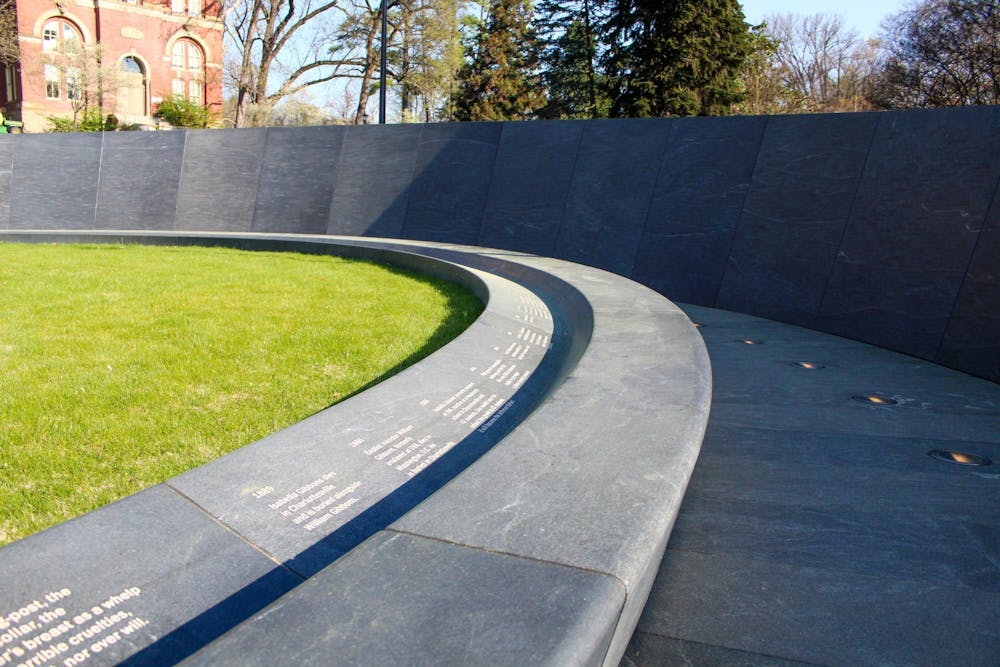When I learned as a first year that a memorial was being built to honor the enslaved individuals who built the University, I was overjoyed. Now, in my fourth year at the University, I find myself cringing every time I see or hear about the Memorial to Enslaved Laborers. There is a level of performative action that University leaders have shown themselves to approve of, and the Memorial currently serves as one of the primary cases. But it is not sufficient to adopt surface-level remediation tactics. Therefore, it is not sufficient to build a long-overdue memorial. The memorialization and de-memorialization process the University has committed itself to is not enough. And every time I see the Memorial, I am reminded of this.
The term enslaved laborer is used as a means for reclamation by many Black people in the country, but I believe it is used as a means of erasure at the University. On multiple occasions I have heard both students and professors say enslaved laborers to reference those who built the University in one sentence, but then say “slaves” instead in a context outside of the University. This gives the impression that the enslavement that took place on Grounds was less inhumane than anywhere else in the country. It was not. The enslaved laborers who were forced to live and work at the University also suffered through brutalities such as rape and severe beatings from the time construction of the University began in 1817 until enslavement was abolished in 1865. The reality of enslavement at the University was no more merciful than it was anywhere else in the country. The term enslaved laborer is meant to separate the person from the situation they were forced to endure, but when it is only used in the context of the University, I believe it becomes a means of erasing the years of suffering those who lived and worked here endured.
For many people, the Memorial serves as a beautiful means of recognition of the hard work slaves were forced to do at the University. For me, though, it serves as a painful reminder of the University’s tendency to do the bare minimum in recognizing its malfeasances. The University and its community members have a long and disturbing history of participating in white supremacy that runs through all 203 years since its founding and continues today. It is no secret our Grounds have served as a hotspot for racial struggle and a favorable stage for bigots to espouse their beliefs. When I think of the existence of the Memorial, I am reminded of all of the heinous acts carried out on Grounds against people of color.
The making of the Memorial was no small feat for those who worked tirelessly to see it actualized. I admire and recognize the accomplishments of the Descendants of Enslaved Communities at U.Va. and all community members who had a part in bringing the Memorial to life. In this way — and this way only — I do not hate the Memorial. It is truly a culmination of community-based effort and thoughtful design practice. I do not like, however, how it is often heralded as a University accomplishment and not the accomplishment of those who put their effort and time into its conception.
The Memorial is located east adjacent to the Rotunda, tucked next to Brooks Hall. The location is reminiscent of the Office of African American Affairs which is placed in, what is essentially, New Cabell’s backyard. Both are tucked away and seemingly hidden. Also, the Memorial is often misused by visitors. Children climb its walls, skateboarders skate through it and people treat it as a photo-op. Abuse is a risk taken when the only proper memorial to the enslaved laborers who built the Univeristy is so publicly accessible. There must be more moments of memorialization for the people of color who were exploited and mistreated in building the University outside of this one memorial.
A few weeks ago, the University Instagram account posted a series of images titled “Top Instaworthy Spots on Grounds” — the MEL was listed as number 3 before the post was deleted. Since the beginning of the fall semester, we have also seen the OAAA vandalized and a noose tied around the neck of the Homer statue. While some in our community watch in shock when these incidents occur, students of color already know the grievous acts of hatred people are capable of at the University. And we also know people are bold enough to carry out these actions because the University has not taken proper action to prevent them from happening. I choose to believe there have to be people in power at the University who are currently working towards appropriate improvements to the lives of marginalized students. But as a marginalized student myself,I can no longer be patient enough to wait for that work to be unmistakably visible. Because it is an example of performative action, the Memorial to Enslaved Laborers is not a prominent enough model of the work being done.
Aliyah D. White is an Opinion Columnist who writes about identity and culture for The Cavalier Daily. She can be reached at opinion@cavalierdaily.com.
The opinions expressed in this column are not necessarily those of The Cavalier Daily. Columns represent the views of the authors alone.







